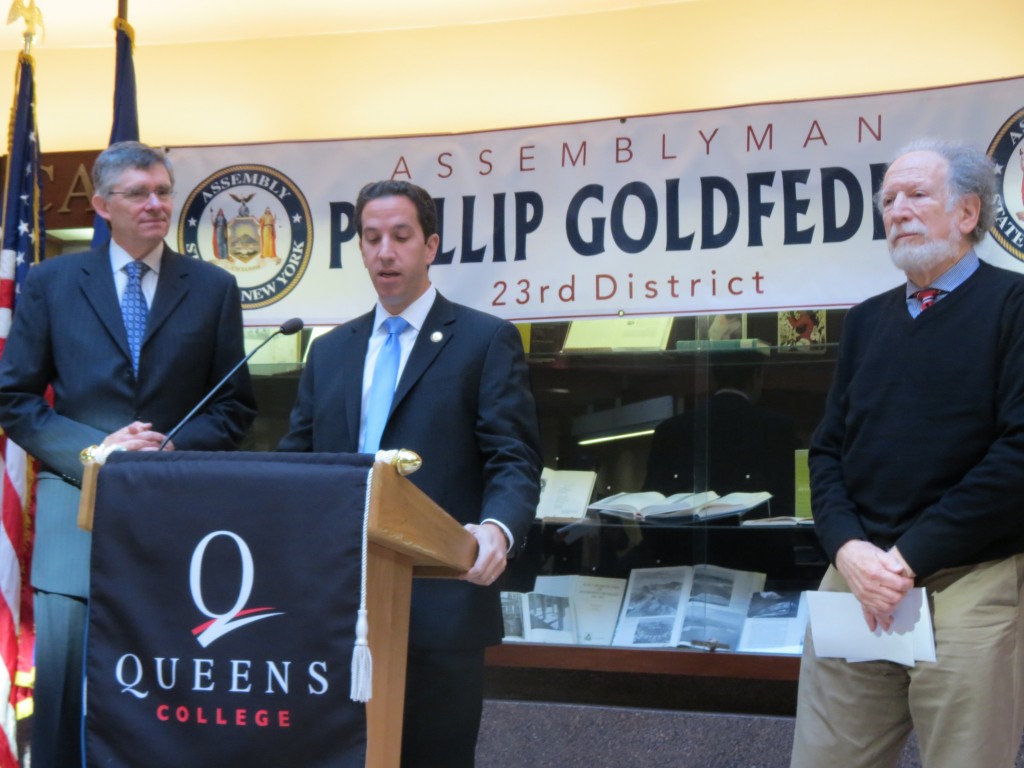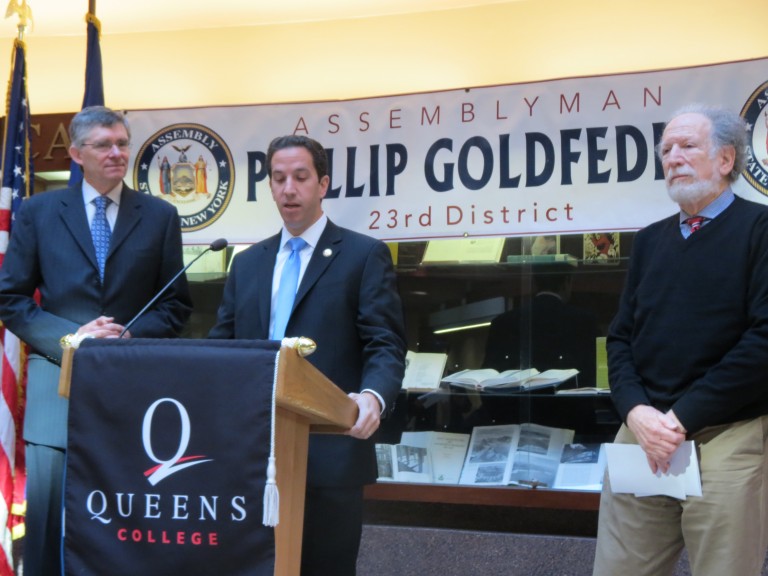
Queens College President James Muyskens, left, Assemblyman Phil Goldfeder, and Department of Urban Studies Chairman Leonard Rodberg announced Monday that the college will soon launch a study on proposals for the abandoned Rockaway Beach Rail Line. Anna Gustafson/The Forum Newsgroup
Proposals for the abandoned Rockaway Beach Rail Line, including reactivating the train service and turning the space into a park similar to Manhattan’s High Line, will land further scrutiny in a soon to be launched study by Queens College, school officials and state Assemblyman Phil Goldfeder (D-Rockaway) announced Monday.
The study, which will be conducted by graduate and undergraduate students in Queens College’s Department of Urban Studies, will begin this spring and will assess the community impact of the different options proposed for the rail line, which once ran from Rockaway to Rego Park before being abandoned about 50 years ago.
“The key to our success as a borough, and city, is to expand our public transportation infrastructure,” said Goldfeder, who has long been a proponent of reactivating the rail line. “…Who better to talk about what’s in the best interest of our community than our own Queens experts?”
Queens College representatives stressed that the study would look at the impact of reactivating the line, as well as the park, known as the QueensWay, that would transform 3.5 miles of the abandoned line into green space. Other residents have been opposed to both proposals as they stand, including Neil Giannelli, founder of the group No Way QueensWay. Giannelli, a Woodhaven resident, and others living near him on 98th Street, have said they harbor serious concerns about security and decreased property values with any kind of development on the tracks.
“We will look at them all – and look at them objectively,” Leonard Rodberg, chair of Queens College’s Department of Urban Studies, said of the proposals.
The study will be primarily overseen by Scott Larson, a lecturer in the Department of Urban Studies, who said students will begin the project in the spring and potentially wrap it up by the end of the summer. Rodberg noted that the students will look at existing data, including U.S. Census numbers, as well as gather new data to assess the proposals.
Goldfeder said he may be able to allocate $50,000 to $100,000 from the state for the study.
“We’re always thrilled when expertise of our faculty can be used to solve problems for the people of Queens,” Queens College President James Muyskens said.
The line, which, in addition to Rockaway and Rego Park, traveled through Forest Hills, Middle Village, Woodhaven, Ozone Park, and Howard Beach, was once owned and operated by the Long Island Rail Road but was sold to the city in 1962. The city abandoned it, and, over the past five decades, the line has fallen into disrepair, its tracks covered by unruly weeds and graffiti.
Both supports of the QueensWay and reactivating the line have said their respective proposals would benefit residents throughout the borough. Park proponents often cite there being about 250,000 residents in the area surrounding the proposed 3.5-mile line whose quality of life would be boosted by the green space, while those who want the line reactivated have said it would bring crucial economic development to South Queens and the Rockaways – areas that are underserved by mass transportation.
There is another study being done on the area, though it is solely on the QueensWay proposal. In August, the Trust for Public Land and Friends of the QueensWay announced that a $467,000 grant from the state’s Office of Parks, Recreation and Historic Preservation would help to pay for a year-long study on how to transform the area scarred with litter and weeds into a spot some are calling the borough’s High Line.
“The QueensWay is going to be New York’s next great park,” Marc Matsil, the New York state director for The Trust for Public Land, said when the study was launched.
But Phil McManus, a public transportation advocate and Rockaway resident, said at Monday’s announcement at Queens College that a new rail line would bring much-needed economic growth to a Rockaway that has long been hit by financial burdens – and now even more so in the wake of Hurricane Sandy.
“I love this,” McManus said of the Queens College study. “…This’ll educate the public – most people don’t know about this.”
“If our population was declining, I’d say we’ll never get this, the rail line, but our population [in Queens] is increasing,” McManus continued.
By Anna Gustafson

